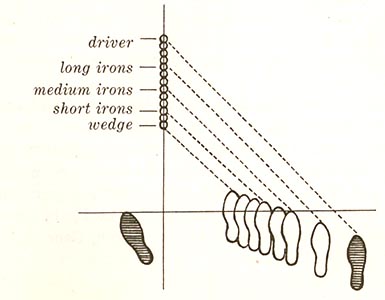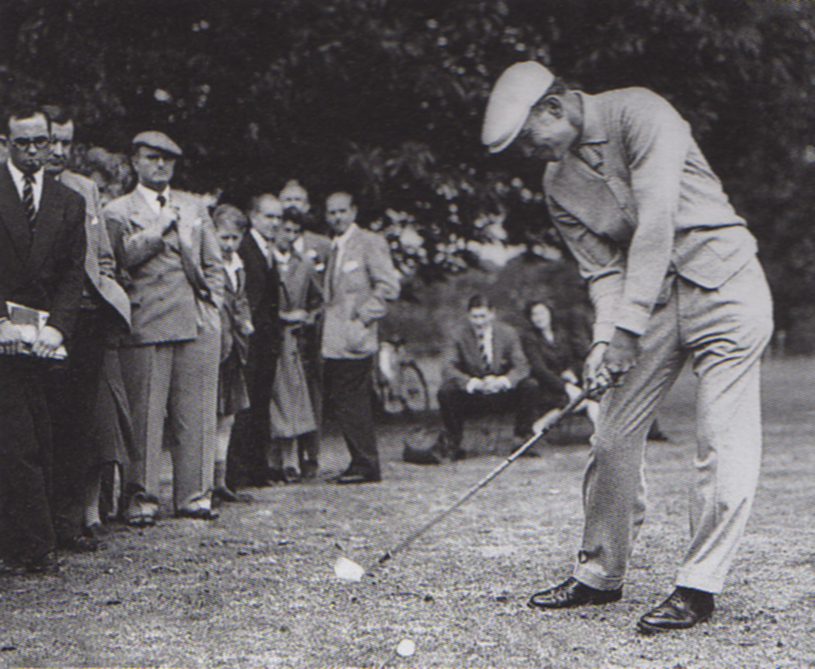
Saturday I got to use the Trackman launch monitor for purposes of finding out what my impact conditions were saying. Before that, I had just made a breakthrough in Module 3 and just started to 'CP Release/Swing Left' with angled hinge on a lot of my golf swings. I didn't bother getting the results e-mailed because I switched clubs and didn't keep track with them. But, I saw the results after each shot and here's what they looked like:
IRONS
The attack angles were generally a bit shallower than the PGA Tour average, but nothing too shallow. I would say with a 7-iron, it was probably about -2.8*. I probably would go as steep as the PGA Tour average, but not very often did I go steeper than that.
But, my other average numbers would look something like this:
0.0* path
-4.0* HSP
-2.0* Path
So, I was indeed 'swinging left' and probably over-doing it a tad.
This was big for me because it looked like the ball flight was pretty straight, but there was a small fade in there that I didn't notice until I really observed it.
One of the thngs I found was that I aimed my body a bit too far left at address. Once I made some changes with that, the path would start 'zeroing out' with the face. Although making that adjustment was a little weird for me. I played 18 after the session and flagged a bunch of iron shots that day.
This is very similar to what Graeme McDowell is doing here:
As you can see, McDowell says to the effect that when he aims square, his path goes about 2* to the right. My stance is more along the lines of the Hogan stance diagram.

So with the irons, I was aiming a tad bit too far left with them and once I aimed slightly more to the right with the body, my path got close to square.
DRIVER
It was easy to see why I've become a very good driver of the golf ball. I pretty much was zeroing out everything. What exactly was that?
- Attack Angle
- Face Angle
- HSP
- Path
So the way I was aimed with the driver was just fine and in fact, I just need to trust myself with the driver even more. Occasionally I would get a steeper attack angle, usually right at -2.0*, but for the most part, I was at zeroes with everything.
Now, there's a swing I can do where I tee it up very high and move the ball position way up to hit the ball with a positive attack angle. When I do this, I gain about 40 yards off the tee. I also found that I pretty much would get this at +4.5* attack angle every time.
However, when you are trying to 'CP Release' and hit up like this, I need to aim wayyyyy to the right. So what I do is when I want to hit this shot is aim the face a bit more to the right of the target and then aim the body almost extremely right of the target. If I don't, I usually hit a pull. I only do this shot on wide open holes with plenty of room left.
All in all, it was a very productive hour. Of course, I got a lot of questions when I posted this up on the forum.
How much does it cost?
It cost me $75 per hour. Usually these places that own Trackman charge something like $100 or so for an hour for *fitting*. This place actually charges $125 per hour for fitting. You should get a cheaper price for this type of ordeal since all they have to do is set it up.
What's the process to do this?
Just e-mail the owner and say you would like to rent a Trackman for an hour and you're just looking for the data to help with your swing. Many owners don't use Trackman for lessons, so this may come off as an odd request, but assure them you are just there to use it for your own data.
How long does this take?
After 20 minutes in the heat, I was sweating up a storm. It really only takes an hour. They can set up a Trackman in about 5 minutes. The data will probably be on a laptop like it was mine. Anybody who can have very basic computer skills can figure it out. I would basically hit a shot, then go back to the laptop about 10 feet away and look at the data.
Any possible problems?
1. You have to be aware of where the target is and make sure it's aligned to where you are aiming. For instance I was hitting very slight fades at the target we selected. But when I looked at the data, it was basically saying I should be hitting a sizeable pull.
Eventually I started aiming a bit right of the target and hitting shots at this new target and figuring out where he had the Trackman aligned.
2. If you take big enough divots, sometimes it won't register the numbers. I had used Trackman twice before and with the irons, you may have to tee some shots up. You can tee them up just like you would on a par-3 though and still take a divot and have the numbers show up properly.
What are the optimal numbers?
Depends what you are looking to do. But I would say that Attack angle is mostly about consistency. Path and face are about consistency as well. But if you want to hit shots dead straight at the target, you need to 'swing left' enough for that to happen.
What is the best thing about working with Trackman?
I only did about 1/4 of all you can do on Trackman, but you're likely to get at least one surprise with your shots. For me, it was that with the irons I swung the club a little more left than I needed to and was hitting a tiny fade and that if I aimed my body slightly right of where I normally do with the irons, I could zero things out.
I also understood that my missed shots were mostly errors with the clubface. I didn't have many missed shots, but if I hooked one, the face got a little too closed and was left of the path, causing a pull hook. With the occasional push, the face was just out to the right too much.
But the big thing is that I certainly felt I made the most out of my practice time, which is important to me because I have limited practice time. Plus you start to correctly analyze what you need to work on and avoid working on stuff that's not important.
Personally, I highly recommend working on Trackman if you're serious about lowering your scores.
3JACK










